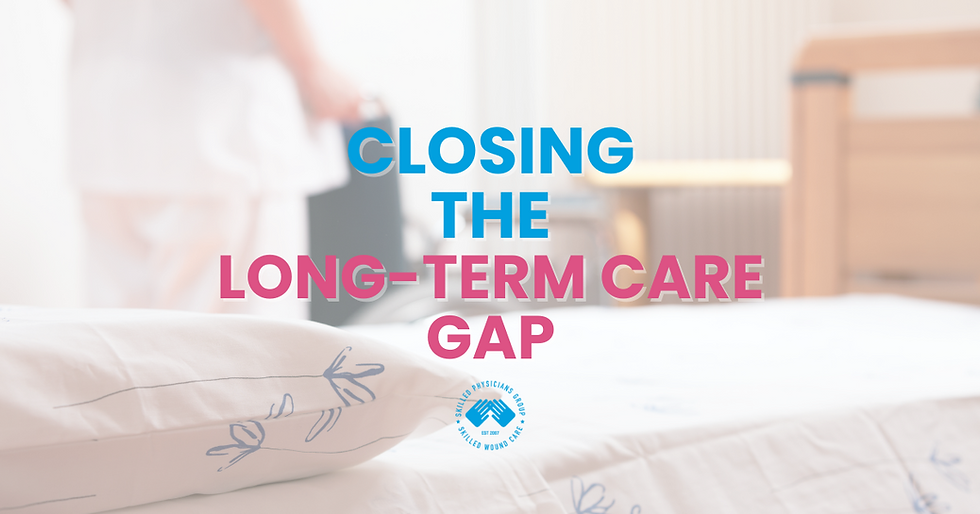Closing the Long-Term Care Gap
- Skilled Wound Care

- 6 days ago
- 4 min read
How Physician-Led Wound Care is Reshaping Facility-Based Medicine
The long-term care landscape in America is evolving, but not fast enough. Facilities are caring for more medically complex residents than ever before, yet many still operate without consistent physician presence, timely specialty care, or the clinical infrastructure needed to prevent complications before they escalate.
This growing divide between need and access is what many in the industry refer to as the long-term care gap. It is a problem that affects patient outcomes, regulatory compliance, and staff morale. At Skilled Wound Care, we’ve made it our mission to close that gap patient by patient, facility by facility, and market by market. What Is the Long-Term Care Gap? The gap is more than a staffing shortage. It is the difference between the care that should be delivered and the care that is realistically available in many skilled nursing facilities today. It includes:
Inconsistent physician presence
Delayed specialist referrals
Lack of bedside procedures
Fragmented communication
Gaps in staff training and clinical education
Overreliance on hospital transfers for manageable conditions
For residents with chronic wounds or post-operative complications, this gap can quickly result in delayed healing, avoidable hospitalizations, and worsened outcomes. For the facility, it leads to deficiencies, penalties, and challenges in maintaining five-star ratings.
Why the Gap Exists
The post-acute care system was not built to keep pace with today’s volume or acuity levels. Many facilities were designed to support rehabilitation after short hospital stays. But today’s skilled nursing facilities are increasingly home to older, more complex residents with multiple chronic conditions, limited mobility, and high risk for complications like pressure injuries and infections.
Meanwhile, hospitals are discharging patients sooner, and outpatient care models assume patients can travel, communicate, and advocate for themselves. That’s not always the case in long-term care.
Without on-site physicians regularly present, nurses are left managing wound complications, coordinating referrals, and troubleshooting emergencies without adequate support. In many cases, wounds worsen while waiting for consults, and by the time a specialist is involved, hospitalization becomes unavoidable.
Closing the Gap with a New Model of Care
At Skilled Wound Care, we don’t believe that long-term care should mean second-tier care. We place trained wound care physicians directly inside skilled nursing facilities where they round consistently, perform bedside procedures, and partner with staff to drive better outcomes from the inside out.
This model addresses the long-term care gap in several key ways:
Consistent Physician Rounding: Our providers are not visitors. They become a part of the facility’s weekly clinical rhythm. This consistency allows wounds to be monitored in real time, and treatment to begin or change the moment it’s needed. Healing doesn’t wait, and neither do we.
Bedside Procedures Without Delays: With physicians on-site, procedures like debridement, biopsies, and culture collection happen at the bedside, often the same day a concern is identified. This eliminates the lag time created by referrals, transportation, and scheduling barriers that exist outside the facility.
Real Collaboration with Facility Staff: We work hand-in-hand with nursing teams, not above or around them. Our physicians are a resource for staff education, pressure injury staging, and survey preparation. We also provide guidance on documentation that supports both regulatory compliance and clinical continuity.
Reduced Hospitalizations: By addressing wounds early and aggressively, we help prevent infections, sepsis, and worsening tissue damage. This reduces the need for emergency transfers, preserves continuity of care, and keeps patients safely in the environment they call home.
Improved Survey Readiness and Outcomes: Facilities that work with Skilled Wound Care often report stronger survey results, improved documentation, and better wound-related metrics. This leads to higher star ratings, better reputations, and more confident staff and families. The Human Impact Behind every metric is a patient. A woman recovering from a hip fracture who develops a pressure injury before discharge. A man with diabetes whose leg ulcer won’t heal. A veteran whose surgical site is slow to close due to malnutrition and poor circulation.
Without intervention, these wounds don’t just linger, they worsen. They lead to infection, pain, and avoidable decline. But with consistent physician oversight and hands-on care, they heal.
Closing the long-term care gap is about more than checking boxes. It is about restoring dignity, mobility, and comfort to people who are too often overlooked by a system not designed for them.
A Better Future for Post-Acute Care
The long-term care industry is at a crossroads. Facilities that adapt and invest in proactive clinical models will not only survive, they will thrive. Those that continue to operate reactively, hoping that hospital discharges will stabilize on their own, will struggle to keep up.
Skilled Wound Care is helping to lead that change. Our model scales across regions, supports physician growth, and strengthens the partnership between providers and the facilities they serve.
This is how the long-term care gap closes: not all at once, but with committed teams, better systems, and a willingness to reimagine what care should look like in the places patients need it most.
Interested in learning how we support long-term care facilities nationwide? Visit www.skilledwoundcare.com to learn more about our physician-led wound care model and how it’s helping facilities across the country close the gap, for good.





Comments